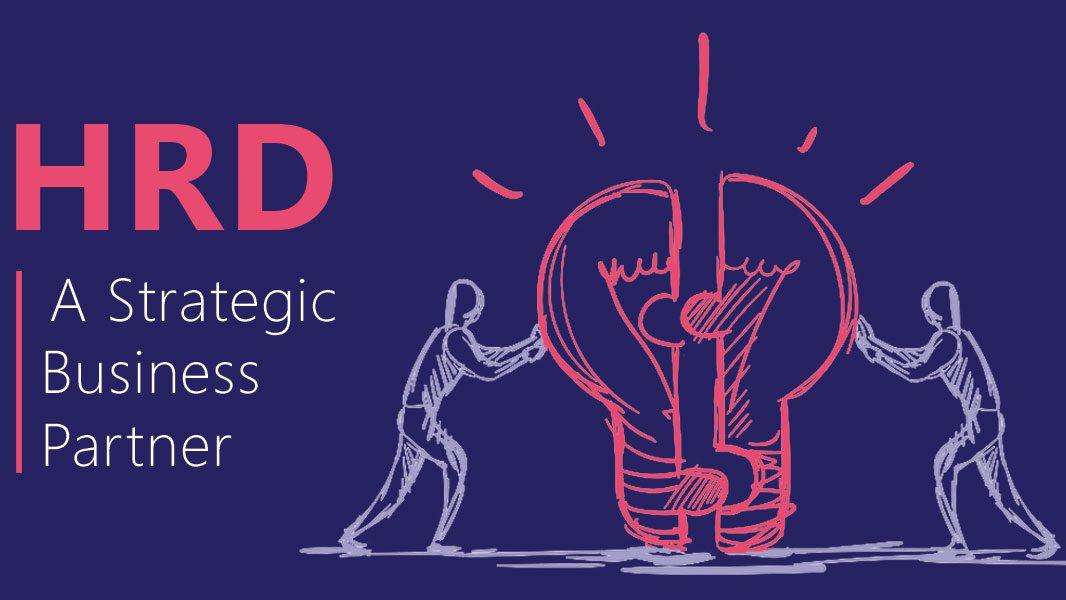
HRD: A Strategic Business Partner
In the year 1920, the Industrial Revolution created an urgency to develop a separate business unit for managing human resources due to the occurrence of various employee-related challenges. This department was called the personal department in those days. Since then the HR department went through several modifications and today after a century it has evolved into a strategic business partner unit that plays a crucial role in developing a high-performance organization (HPO).
In the present era, thenHR department handles its primary task of managing the transactional-basednadministrative duties which were assigned to it since the advent of thenindustrial revolution but in addition to this, it also now functions as angoverning body in the organization that aims in improving the workforce in order to increase organizational capabilities. The well-known Professor DavenUlrich and Professor Dale Lake in their research paper OrganizationalnCapabilities: Creating Competitive Advantage defines OrganizationalnCapabilities as, “A business’s ability tonestablish internal structures and processes that influence its members toncreate organization-specific competencies and thus allow the business tonacclimate to changing customer and strategic needs”. In order to, increasenthis Organizational Capabilities HR has transformed into Human ResourcenDevelopment (HRD).
Gilley and Maycunich, thenHuman Resource Management experts define HRD as, “The process of facilitating organizational learning, performance, andnchange through organized (formal and informal) interventions, initiatives, andnmanagement actions to improve an organization’s performance capacity,ncapability, competitive readiness, and renewal”
Today, as a strategic business partner HRD focuses on four key areas:
- Individual Development (ID)
- Talent Management
- Performance management
- Organizational Development
Individual Development:
Individual Development pays attention to enhancing employee knowledge, skills and competencies in order to improve their work performance which will indirectly contribute to the sustainable development of the organization. This is done by organizing training sessions or programs that upgrade employee understanding and knowledge. Apart from various training programs, HR department conduct activities that help employees;
- To get attach to the values, principles, vision, and mission of the organization.
- To sync with the organization’s business partner objectives
- To think systematically, keeping in mind the organization’s culture, strategy, profit, and management practices.
- To work together as a team dissolving personal diversities
- To have a shared vision that goes hand in hand with the progress of the organization
Talent management:
This includes recruiting,nselection, remunerations, appraisals, employee management, and motivation. Thenpurpose of talent management is to have the right people in the right positionsnto maintain the right environment for attaining the right results. They focusnmore on employee satisfaction and retention. If the talent within thenorganization is managed properly it increases employee commitment, improvesnmorale and motivates employees to give an extra punch to their performance.
Performance management
This area focuses on aligning the objectives of the employees with the organization’s mission. The process of performance management system includes setting up individual targets for employees and then evaluating them regularly to reduce the gaps and ensure that fruitful results are achieved. Here, the HR department steps out of their traditional administrator’s role to perform following task;
- Identifying gaps or barriers that hinder employee performance and finding solutions to resolve them.
- Implementing performance management system that help in solving problems rapidly and efficiently.
- Developing a hierarchy system that increases employee participation in managerial roles in order to identify and solve problems quickly for an employee as well as customer satisfaction.
- Defining job roles and performance standards for each job classification
- Creating performance measures
- Developing competency maps
- Identifying training opportunities to dissolve gaps between actual performance and expected performance
- Developing incentive and reward systems that motivate employees to perform well and improve performance as required.
By developing andnimplementing above, HR professionals have a definite opportunity to lead thenorganization on the path of success.
Organizational Development:
Organizational Development has a macro perspective. To develop an organization as whole HR professionals need to work on micro-levels.
- Improving the work culture of an organization that would adapt easily to the changing nature of the business.
- Making open economic policies that would help the organization to grow rather than hindering the growth.
- Encouraging leaderships that would bring out best among the people and guide the organization towards success
- Undertaking innovating solutions that help the organization develop and grow.
An evolution from HR to HRD and transformation from administrators to strategic business partners has put HR professionals into a position in which they can make a significant contribution to the organizational performance through the development of systems that needs to establish continuous improvement and hence, the growth.
Complete campus to corporate training module for the IT industry

Vinsys is a globally recognized provider of a wide array of professional services designed to meet the diverse needs of organizations across the globe. We specialize in Technical & Business Training, IT Development & Software Solutions, Foreign Language Services, Digital Learning, Resourcing & Recruitment, and Consulting. Our unwavering commitment to excellence is evident through our ISO 9001, 27001, and CMMIDEV/3 certifications, which validate our exceptional standards. With a successful track record spanning over two decades, we have effectively served more than 4,000 organizations across the globe.
